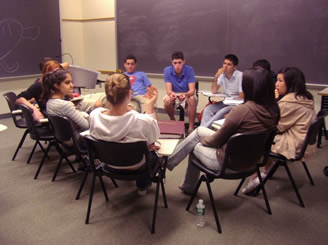“A group problem-solving technique that involves the spontaneous
contribution of ideas from all members of the group”
— Merriam-Webster Dictionary
 Brainstorming is one of many creative problem solving techniques. While you can use any size group, we believe it works best when done in a facilitated group of 5-10 people. The more diverse the group the more diverse the input. The group members don’t need to be experts in your field. In fact, they don’t need to know anything about the problem topic at all!
Brainstorming is one of many creative problem solving techniques. While you can use any size group, we believe it works best when done in a facilitated group of 5-10 people. The more diverse the group the more diverse the input. The group members don’t need to be experts in your field. In fact, they don’t need to know anything about the problem topic at all!
Step 1: Define Your Problem
You need to get really clear on what your problem truly is (and is not). Keep asking “why?” until you feel that you’ve identified the root of your problem. For example, if your problem is “I need more money?” Ask “Why? To do what? And then what?”. Once you have the problem, state the brainstorming topic as:
“I would like to _________ but it’s difficult because ________”
The more time you spend in defining your problem the better the results will be.
Step 2: Uncover Solutions
Now is when the group starts contributing ideas. The group should some pre-agreed rules. Here are some:
- I will listen to others’ ideas.
- I will not be attached to my idea.
- I will attempt to find the good in someone else’s ideas.
- I will give myself permission to be wrong, insane, and stupid.
- I will respect that the person with a problem is best judge as to quality of the idea.
- I will not tell someone else what to do, I will only offer suggestions.
Make sure you have someone responsible for recording the meeting (that person should definitely not be the person who’s presenting their problem).
Brainstorm for a set time. Initially, a lot of obvious ideas will be suggested. After this initial flurry, things will quiet down. Be patient. Risk saying something that makes no sense to you. The better ideas usually arrive after people have relaxed and listened to others.
Step 3: Evaluate Solutions
Here is where the solutions that were suggested can be evaluated. What ideas are the most exciting? If any of the ideas seem incomplete, go back to step 1 and re-brainstorm.
Remember that brainstorming can be an intensely intimate encounter. Thank everyone for their contribution.